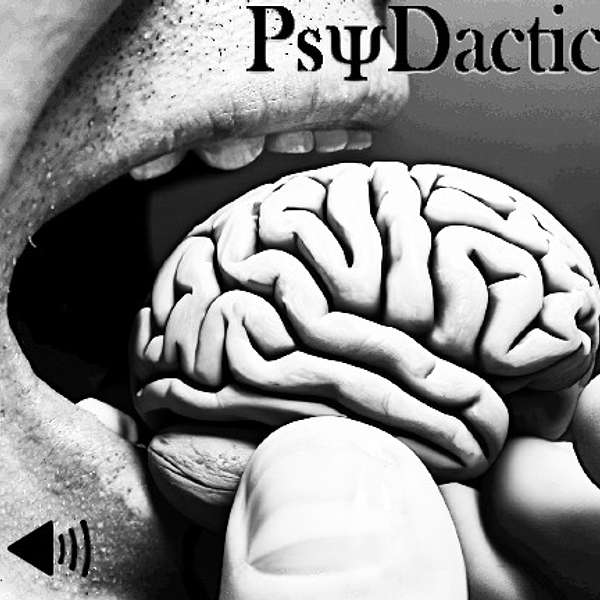
PsyDactic
A resource for psychiatrists and other medical or behavioral health professionals interested in exploring the neuroscientific basis of psychiatric disorders, psychopharmacology, neuromodulation, and other psychiatric interventions, as well as discussions of pseudoscience, Bayesian reasoning, ethics, the history of psychiatry, and human psychology in general.
This podcast is not medical advice. It strives to be science communication. Dr. O'Leary is a skeptical thinker who often questions what we think we know. He hopes to open more conversations about what we don't know we don't know.
Find transcripts with show-notes and references on each episodes dedicated page at psydactic.buzzsprout.com.
You can leave feedback at https://www.psydactic.com.
The visual companions, when available, can be found at https://youtube.com/@PsyDactic.
PsyDactic
The Medial Prefrontal Cortex
This episode continues a series on the prefrontal cortex, a complex region of the brain that gives us the ability to have the kinds of thoughts no other species on earth is known to have. The medial (or mesial) prefrontal cortex is especially important for emotional and autonomic regulation, attention and goal-directed behaviors (including addiction), and building our sense of self (that is our identity as a thing separate from the world around us), and considering salient aspects of the social context we are in and what others might be thinking (among many other things).
Please leave feedback at https://www.psydactic.com or send any comments to feedback@psydactic.com.
References and readings (when available) are posted at the end of each episode transcript, located at psydactic.buzzsprout.com. All opinions expressed in this podcast are exclusively those of the person speaking and should not be confused with the opinions of anyone else. We reserve the right to be wrong. Nothing in this podcast should be treated as individual medical advice.
Welcome to PsyDactic - Residency Edition. Today is Monday, August 7, 2023, and I am Dr. O’Leary, a 4th year psychiatry resident who likes to punish himself by assigning extra work like researching and producing podcast episodes. For the new listeners out there, I would like to consent you as you consume my ramblings that I produce these episodes myself based on my likely deficient understanding of what smarter people have written down. My opinions are my own. The only people who are consistently fact checking me are my listeners, so if you want to comment on anything I say here, please go to psydactic.com and fill out the response form there. For those interested, I also have some links at the end of the show transcript at psydactic.buzzsprout.com that I used when preparing this episode.
Today, I continue a series on the prefrontal cortex, a complex region of the brain that gives us the ability to have the kinds of thoughts no other species on earth is known to have. In the last two episodes, I discussed the orbital frontal cortex and the dorsolateral prefrontal cortex. If you haven’t been following this series, then I highly recommend you start three episodes back where I summarize the entire prefrontal cortex. Today, I am discussing the medial prefrontal cortex. I have also just recently discovered that it is also referred to as the mesial prefrontal cortex. Replacing the “d” in medial with an “s” gave me entirely different search results. I suspect that little things like this have a large reverberating effect on how knowledge is shared. Today I am going to refer to this area as the “medial” prefrontal cortex.
The medial prefrontal cortex, like the OFC and DLPFC, is variously defined based on who is describing it and for what purpose. I likewise found it especially difficult to figure out what subregion of the mPFC was being referred to when various authors were ascribing functions to this region. Anatomically, we could talk about entire surface of medial prefrontal cortex that includes the orbital medial prefrontal cortex, the ventral medial prefrontal cortex and the dorsal medial prefrontal cortex which often also includes discussion of the anterior cingulate gyrus. These regions have also been divided, especially in animal studies, into the anterior cingulate cortex, the prelimbic regions (which, I think, is synonymous with the dorsal medial prefrontal cortex), and the infralimbic regions (which seems to mean the ventral medial prefrontal cortex). It becomes more confusing because the cingulate gyrus is often included as part of the limbic cortex and the rest of the medial prefrontal cortex may or may not be. What is important to know is that the mPFC is especially important for emotional and autonomic regulation, attention and goal-directed behaviors (including addiction), and building our sense of self (that is our identity as a thing separate from the world around us), and considering salient aspects of the social context we are in and what others might be thinking (among many other things).
To do all of these things, the medial prefrontal cortex needs to be connected to many brain regions. To probe our memories it has strong connections to the medial temporal lobe including the hippocampus, and the entorhinal and perirhinal cortex. To know how we feel or control how we feel, it is extensively connected to the amygdala and periaqueductal gray matter and to various brainstem nuclei. To help motivate us and prepare us for goal-directed action, it is connected to the nucleus accumbens, the caudate, the putamen. To help us to understand our own tastes, preferences, and goals, it communicates extensively with the orbitofrontal cortex and the DLPFC. It is communicating back and forth from the mediodorsal thalamic nucleus, which has extensive connections with the limbic system and other parts of the prefrontal cortex. It is not, however, directly driving our actions. Like the OFC it is more involved with determining goals and promoting motivation. Our actual actions are coordinated by other brain regions.
With the exception of the anterior cingulate, parts of the medial prefrontal cortex participate in what has been called our default mode network. The default mode network includes the posterior cingulate cortex, parts of the precuneus and inferior parietal lobe, and much of the medial prefrontal cortex. The DMN becomes more active when we are relatively relaxed and self-referential, and especially when we are in deep, ruminative thought. On the other hand, when we are engaged in activities that require attention to be more outward or externally focused (i.e. that require more consideration of sensory input and demand a high cognitive load), the Default Mode Network is suppressed by the Central Executive Network in a process called anti-correlation. It was originally thought that these two networks would always anticorrelate, but that appears to be an artifact of the kinds of tasks people were asked to do when they were in the scanners. Creative thinking in the abstract, for example, seems to require these networks to correlate and coordinate their activity, instead of suppressing each other.
Although the mPFC is not receiving direct sensory input, it responds to aspects of the environment. For example, parts of the mPFC are activated when we are viewing a scene, such as when we are watching a movie and then people arrive. It appears to be an essential component in determining our social awareness and aids in responses such as empathy. Deficiencies in mPFC activity may contribute to conduct disorder and antisocial personality disorder. Reduced function of the medial prefrontal cortex have been found in individuals with autism spectrum disorder and social skills training was shown to increase activity in the mPFC.
Affect regulation can also be difficult for individuals with autism, with PTSD, antisocial and borderline personality disorder, and many other psychiatric disorders. The mPFC can exert some top-down control on our affective responses, telling us to some degree how we ought to be feeling right now or if our feelings match the context we find ourselves in. The medial prefrontal cortex’s link to emotional regulation has been modeled primarily in animals as a fear or stress response followed by extinction of that response. With regard to fear learning, the more ventral (or infralimbic) regions of the mPFC may be doing more to suppress fear, while the dorsal (or prelimbic) regions and ACC may be promoting fear-based reactions when needed, but this division of labor has not been definitively demonstrated. What is clear is that managing stress is a high priority and requires a lot of calculus. This calculus is done by the anterior cingulate, and the prelimbic and infralimbic regions of the medial prefrontal cortex. Avoidance of danger is a critical skill for survival, but it also is very costly, so having highly accurate goal-oriented behaviors toward or away from various environmental cues, whether they be immediate, like a cliff’s edge or a stranger in your path, or anticipatory, like the thought that you will be walking home late tonight by yourself.
The more ventral or infralimbic portion of the mPFC projects directly to brainstem nuclei such as the nucleus of the solitary tract (where it could potentially interact with fibers from the vagus nerve) and the rostro-ventro-lateral medulla (which controls sympathetic responses such as the baroreflex). The infralimbic region is thought to be more stimulating or activating to the sympathetic nervous system, but some studies have also noted a suppressive effect. The dorsal or prelimbic portion of the mPFC extends projections to the anterior bed nucleus of the stria terminalis which is connected to the hypothalamus and amygdala and helps to regulate autonomic and neuroendocrine functions. There is some evidence from patients with PTSD that the ventral medial prefrontal cortex plays a large role in hyperarousal by failing to downregulate autonomic responses to non-threatening situations, resulting in hyperarousal, while oversuppression of the amygdala can result in the emotional numbing found in the dissociative subtype.
There is a lot more to learn about the medial prefrontal cortex and the fact that it is tucked deep into the middle of the brain makes it less accessible to techniques like transcranial magnetic stimulation. I believe in the future that we will come to appreciate just how much this underappreciated region plays a role in psychiatric disorders. The part of our cortex that can get us excited, make us afraid or help us to calm down is the same part that lights up when we see a human enter our space, that inspires empathy, that constructs our sense of self and that helps us to understand that other people have their own sense of self. This same part drives what kinds of memories we ponder, what kinds of values we have, what kind of person we should be. I am impressed.
This episode ends my series on the prefrontal cortex. I am not sure exactly what is up next, but everyday I read something fascinating or have a patient that makes me dive a little deeper into the literature and I hope that I have the time to share some of this with you soon. In the meantime, be safe, but not too safe.
I am Doctor O’Leary, and this has been an episode of PsyDactic - Residency Edition.
https://pubmed.ncbi.nlm.nih.gov/31373533/
https://www.ncbi.nlm.nih.gov/pmc/articles/PMC8875599/pdf/nihms-1777305.pdf
https://www.ncbi.nlm.nih.gov/pmc/articles/PMC3678031/pdf/tjp0591-2381.pdf
https://www.ncbi.nlm.nih.gov/pmc/articles/PMC4926239/pdf/zns6917.pdf
https://www.ncbi.nlm.nih.gov/pmc/articles/PMC5005373/pdf/fncir-10-00070.pdf
https://www.frontiersin.org/articles/10.3389/fnbeh.2015.00298/full
https://www.ncbi.nlm.nih.gov/pmc/articles/PMC4580281/pdf/nihms722668.pdf
https://www.jneurosci.org/content/43/20/3675
https://onlinelibrary.wiley.com/doi/abs/10.1002/aur.2603
https://www.annualreviews.org/doi/pdf/10.1146/annurev-neuro-101420-011820
Podcasts we love
Check out these other fine podcasts recommended by us, not an algorithm.

Mindhunting: Journeys in Forensic Psychiatry
Dr Michael Schirripa
Brain Science with Ginger Campbell, MD: Neuroscience for Everyone
Ginger Campbell, MD
